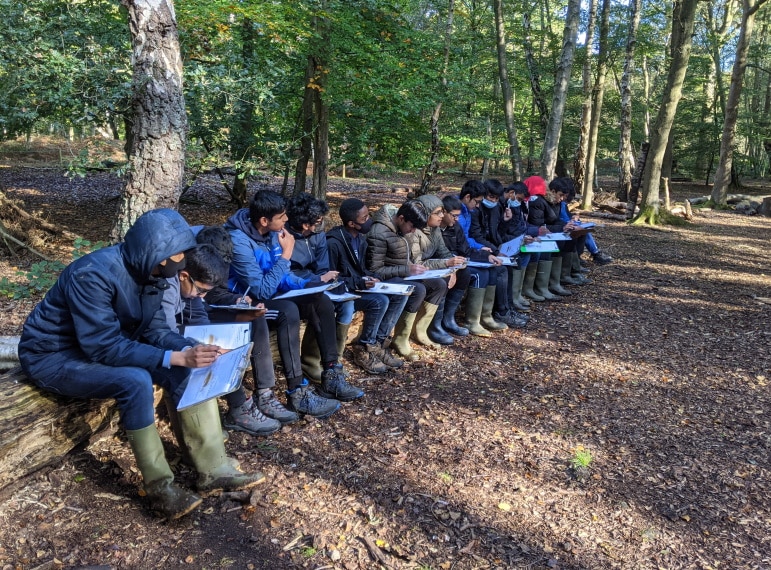
Boys studying Geography headed off to both city and country as field trips returned to their pre-pandemic ‘normal’ for the first time.
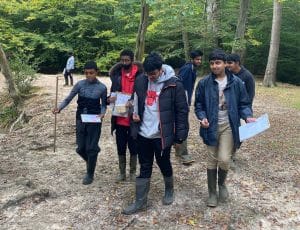 On their Human Geography trip, A-level students investigated gentrification in Wandsworth, where they met residents only too willing to share their views on how their area had changed.
On their Human Geography trip, A-level students investigated gentrification in Wandsworth, where they met residents only too willing to share their views on how their area had changed.
On their more rural trip, pictured, Year 11 geographers encountered some locals, too – deer in Epping Forest – while also having to face the challenge of understanding why the results of their practical investigation did not line up with classroom theory.
Head of Geography Emily Parry said: “We took 159 boys on field trips – 131 Year 11 pupils to Epping Forest over two days and 28 from Year 12 and Year 13 to Northcote ward in Wandsworth.
“It was great to be able to get out again, as so many trips had to be cancelled last year. Fieldwork is a very valuable part of Geography, as it gives the students real-world experience of what they have been studying in the classroom – helping both to consolidate and extend their learning. It also helps them develop skills which are difficult to develop in the classroom alone, such as teamwork and dynamic problem-solving in a changing environment.”
The Year 11 Physical Geography fieldwork in Epping Forest involved answering the question: How do river characteristics change with distance downstream along Loughton Brook? The boys went to three sites along the river and investigated its width, depth, velocity and sediment size & roundness. The fieldwork was led by staff from Epping Forest Field Studies Centre and was part of the AQA GCSE Geography course.
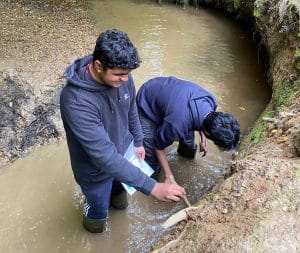 The field trip helped to consolidate boys’ understanding of rivers, which they had previously studied in a unit titled Physical Landscapes of the UK.
The field trip helped to consolidate boys’ understanding of rivers, which they had previously studied in a unit titled Physical Landscapes of the UK.
“We were lucky to have dry weather on both days and fortunate to see the deer,” Miss Parry added.
“We found that the width, depth and velocity did change downstream as predicted by the Bradshaw model, but there wasn’t a clear trend in terms of sediment size and roundness. This was in part due to human error during data collection, and in part due to the fact that this is a seasonal river and that, because of the lack of rainfall recently, water levels were low.”
“This was a valuable learning opportunity, as it enabled pupils to better understand the ‘messiness’ of ‘geographical reality’,” said Miss Parry.
For their Human Geography studies, boys made a short visit in the summer to investigate the question: To what extent is Barnet High Street a successful high street?
 More recently, this month’s visit by Year 12 and 13 pupils to south London had as its goal exploration of the question: To what extent has Northcote ward undergone the process of gentrification? The visit was for part of a unit of study for the Edexcel A-level course entitled Regenerating Places, under which the sixth-formers are looking at the London boroughs of Wandsworth and Newham.
More recently, this month’s visit by Year 12 and 13 pupils to south London had as its goal exploration of the question: To what extent has Northcote ward undergone the process of gentrification? The visit was for part of a unit of study for the Edexcel A-level course entitled Regenerating Places, under which the sixth-formers are looking at the London boroughs of Wandsworth and Newham.
The fieldwork study allowed them to gain first-hand experience of how the borough of Wandsworth has changed. They completed a range of fieldwork techniques, including environmental quality surveys, land-use mapping and questionnaires.
“It was concluded that the Northcote ward area has been gentrified. This was evidenced through the range of boutique and high-end shops found along Northcote Road, the quality of the housing and built environment, plus the changing demographics of the area.
“The boys met some local residents who had lived in the area a long time and were keen to share their views on how the area has changed dramatically in recent decades – some sharing a view that people were being priced out of the area.”
The trip also included one further discovery of note, Miss Parry added: “The Year 12 & 13 boys were very happy to find out there was a Nando’s on Northcote Road where they could have their lunch!”


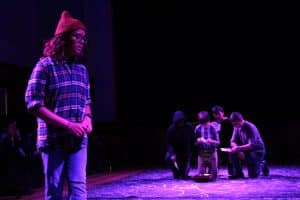 ast drawn from Year 9 performed the play to their year group classmates in the morning and then again to parents, staff and visitors after school.
ast drawn from Year 9 performed the play to their year group classmates in the morning and then again to parents, staff and visitors after school.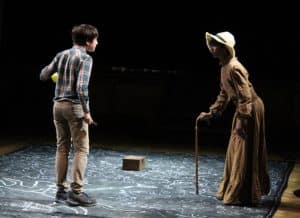 Based on Mark Haddon’s award-winning novel, the moving, darkly comic, and ultimately inspiring story centres on the challenges a boy with autism faces in navigating the world. It also explores themes of family breakdown and the mystery of who killed Wellington, the eponymous dog.
Based on Mark Haddon’s award-winning novel, the moving, darkly comic, and ultimately inspiring story centres on the challenges a boy with autism faces in navigating the world. It also explores themes of family breakdown and the mystery of who killed Wellington, the eponymous dog.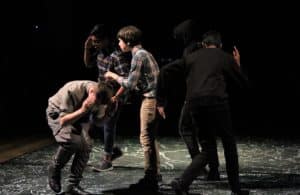 “The cast, technical crew and director were also brilliant, with the performance ‘in the round’ really drawing the audience into the heart of the action. The staging was particularly effective and was aided by the great work on the sound and lighting by Old Elizabethan Chris Newton, of School Stage.
“The cast, technical crew and director were also brilliant, with the performance ‘in the round’ really drawing the audience into the heart of the action. The staging was particularly effective and was aided by the great work on the sound and lighting by Old Elizabethan Chris Newton, of School Stage.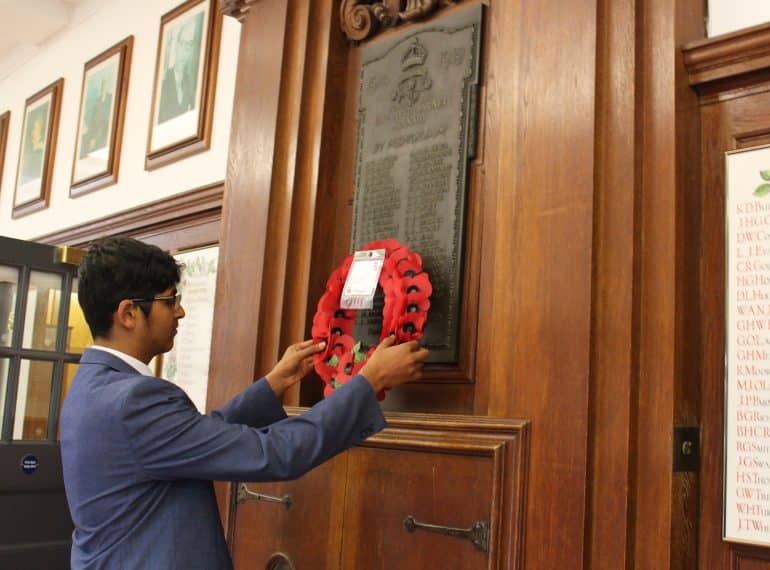
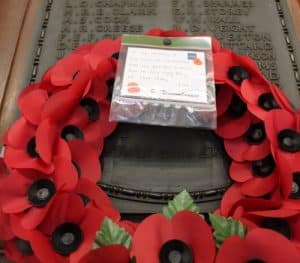 Commissioned at a time when the horrors of the ‘war to end all wars’ were still fresh in the memory, the tablet records the names of 48 Elizabethans who died in the conflict. The memorial may be seen in the ‘crush hall’ of the Main Building, close to the main entrance and Reception.
Commissioned at a time when the horrors of the ‘war to end all wars’ were still fresh in the memory, the tablet records the names of 48 Elizabethans who died in the conflict. The memorial may be seen in the ‘crush hall’ of the Main Building, close to the main entrance and Reception.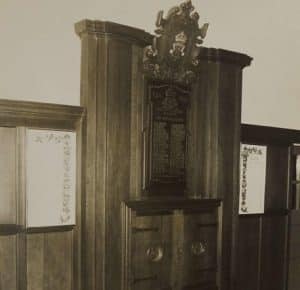 According to the order of service published for the service of dedication, a copy of which
According to the order of service published for the service of dedication, a copy of which 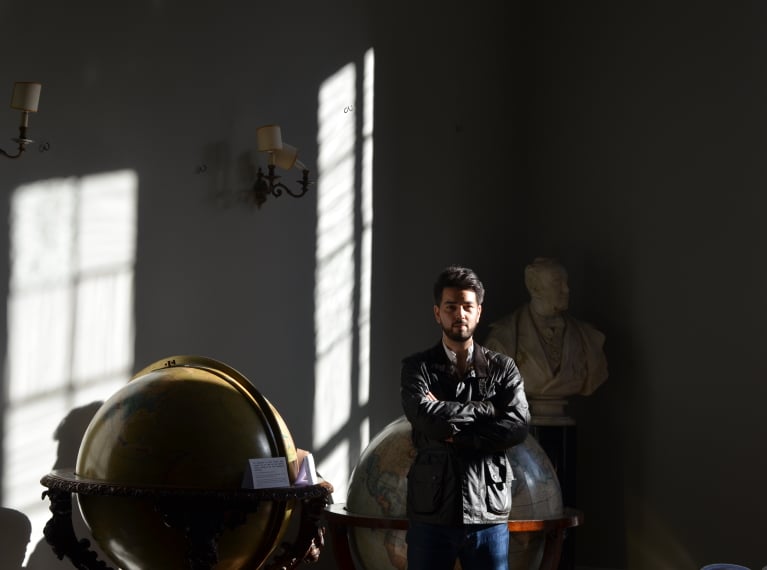
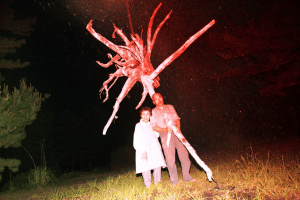 The exhibition
The exhibition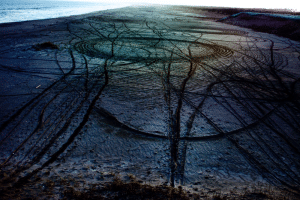 The exhibition, entitled Picturing the Invisible, sees his research interests coming together with his longstanding involvement with the London art scene: while in the Sixth Form at QE, he took part in in the Royal Academy’s attRAct programme and in the Louis Vuitton Young Arts Program; he has also been an Event Manager at the OPEN Ealing community art gallery.
The exhibition, entitled Picturing the Invisible, sees his research interests coming together with his longstanding involvement with the London art scene: while in the Sixth Form at QE, he took part in in the Royal Academy’s attRAct programme and in the Louis Vuitton Young Arts Program; he has also been an Event Manager at the OPEN Ealing community art gallery.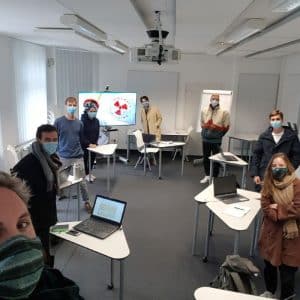 In preparing for it, Makoto says he has been committed to pedagogic innovation to benefit students disadvantaged by the impact of Covid-19 on higher education. “The pandemic has robbed students of so much of the normal university experience, so it’s even more important than ever to innovate new modes of engagement. In this spirit, I integrated preparations for Picturing the Invisible into my teaching at MCTS. Seven students from the Responsibility in Science, Engineering and Technology course have been involved in every step of the planning and [have shared] their perspectives on the works in the exhibition programme, alongside seasoned policymakers, activists, and experts.”
In preparing for it, Makoto says he has been committed to pedagogic innovation to benefit students disadvantaged by the impact of Covid-19 on higher education. “The pandemic has robbed students of so much of the normal university experience, so it’s even more important than ever to innovate new modes of engagement. In this spirit, I integrated preparations for Picturing the Invisible into my teaching at MCTS. Seven students from the Responsibility in Science, Engineering and Technology course have been involved in every step of the planning and [have shared] their perspectives on the works in the exhibition programme, alongside seasoned policymakers, activists, and experts.”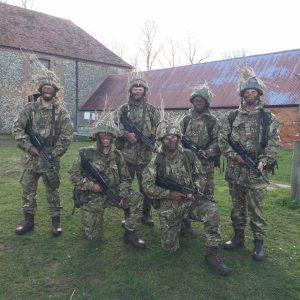 During his schooldays, Makoto threw himself into all that QE had to offer. He was involved in debating, was the leader of the second violins in the Chamber Orchestra and was in the waterpolo team.
During his schooldays, Makoto threw himself into all that QE had to offer. He was involved in debating, was the leader of the second violins in the Chamber Orchestra and was in the waterpolo team.
 Lesley Malpas, Founder and Chief Executive of not-for-profit organisation, Operation Future Hope, not only outlined problems around the world, but also examined environmental depredation close to home, explaining that Britain suffers some of the world’s worst biodiversity loss.
Lesley Malpas, Founder and Chief Executive of not-for-profit organisation, Operation Future Hope, not only outlined problems around the world, but also examined environmental depredation close to home, explaining that Britain suffers some of the world’s worst biodiversity loss.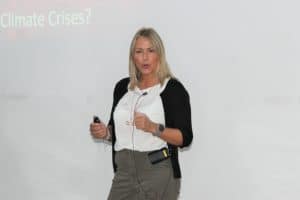 Her positive stories of rewilding included the reintroduction of beavers in Britain, the transformation of what was previously an intensive dairy farm into a wildlife haven that now boasts owls, bats and nightingales in abundance, and the steps taken by a number of schools to improve their sites.
Her positive stories of rewilding included the reintroduction of beavers in Britain, the transformation of what was previously an intensive dairy farm into a wildlife haven that now boasts owls, bats and nightingales in abundance, and the steps taken by a number of schools to improve their sites.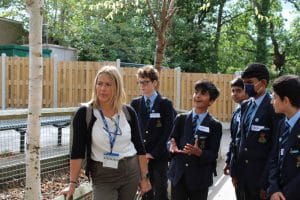 “There seemed to be lots of scope for small initiatives that could have a positive impact and would allow interested students to get actively involved in the School’s stewardship of its grounds,” said Mr Bonham-Carter. “Generally, the site is already supporting nature quite well, she explained, so we are starting this project from a good place. We look forward to receiving her report and understanding further what would be achievable on our campus.”
“There seemed to be lots of scope for small initiatives that could have a positive impact and would allow interested students to get actively involved in the School’s stewardship of its grounds,” said Mr Bonham-Carter. “Generally, the site is already supporting nature quite well, she explained, so we are starting this project from a good place. We look forward to receiving her report and understanding further what would be achievable on our campus.”